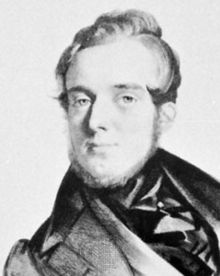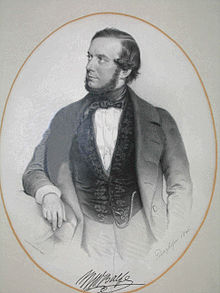- Michael William Balfe
-
Michael William Balfe (15 May 1808 – 20 October 1870) was an Irish composer, best-remembered for his opera The Bohemian Girl.
After a short career as a violinist, Balfe pursued an operatic singing career, while he began to compose. In a career spanning more than 40 years, he composed 38 operas, almost 250 songs and other works. He was also a noted conductor, directing Italian Opera at Her Majesty's Theatre for seven years, among other conducting posts.
Contents
Biography
Balfe was born in Dublin, where his musical gifts became apparent at an early age. The only instruction he received was from his father, who was a dancing master and violinist. His family moved to Wexford when he was a child. Between 1814 and 1815, Balfe played the violin for his father's dancing-classes, and at the age of seven composed a polacca.
Early life and career
In 1817 he appeared as a violinist in public, and in this year composed a ballad, first called "Young Fanny" and afterwards, when sung in Paul Pry by Madame Vestris, "The Lovers' Mistake". In 1823, upon the death of his father, the teenaged Balfe moved to London and was engaged as a violinist in the orchestra of the Theatre Royal, Drury Lane. He eventually became the leader of that orchestra.[1] While there, he studied with C. E. Horn, the organist at St. George's Chapel, Windsor (1786—1840).
As a young man, Balfe pursued a career as an opera singer. He debuted unsuccessfully at Norwich in Carl Maria von Weber's Der Freischütz. In 1825, Count Mazzara took him to Rome for vocal and musical studies and introduced him to Luigi Cherubini. Balfe also pursued composing: in Italy, he wrote his first dramatic work, a ballet, La Perouse. He became a protégée of Rossini's, and at the close of 1827, he appeared as Figaro in The Barber of Seville at the Italian opera in Paris.
Balfe soon returned to Italy, where he was based for the next eight years, singing and composing several operas. He met Maria Malibran while singing at the Paris Opera during this period. In 1829 in Bologna, Balfe composed his first cantata for the soprano Giulia Grisi, then 18 years old. She performed it with the tenor Francesco Pedrazzi with much success. Balfe produced his first complete opera, I rivali di se stessi, at Palermo in the carnival season of 1829—1830.
Around 1831, he married Lina Roser (1806–1888), a Hungarian-born singer of Austrian parentage whom he had met at Bergamo.[2] The couple had two sons and two daughters. Their younger son, Edward, died in infancy. Their elder son, Michael William Jr., died in 1915. Their daughters were Louisa (1832–1869) and Victoire (1837–1871). Balfe wrote another opera Un avvertimento ai gelosi at Pavia, and Enrico Quarto at Milan, where he had been engaged to sing in in Rossini's Otello with Malibran at La Scala in 1834. An unpopular attempt at "improving" Giacomo Meyerbeer's opera, Il crociato in Egitto, by interpolated music of his own, compelled Balfe to throw up his engagement at the theatre La Fenice in Venice.
Composing success
Balfe returned to London with his wife and young daughter in May 1835. His initial success took place some months later, with the premiere of The Siege of Rochelle on 29 October 1835 at Drury Lane. Encouraged by his success, he produced The Maid of Artois in 1836; which was followed by more operas in English.
In July 1838, Balfe composed a new opera, Falstaff, for The Italian Opera House, based on The Merry Wives of Windsor, with an Italian libretto by S. Manfredo Maggione. The production starred his friends Luigi Lablache (bass) in the title role, Giulia Grisi (soprano), Giovanni Battista Rubini (tenor), and Antonio Tamburini (baritone). The same four singers had premiered Bellini's, I Puritani at the Italian Opera in Paris in 1835.[2]
In 1841, Balfe founded the National Opera at the Lyceum Theatre, but the venture was a failure. The same year, he premiered his opera, Keolanthe. He then moved to Paris, presenting Le puits d’amour (1843) in early 1843, followed by Les quatre fils Aymon (1844) for the Opéra Comique (also popular in German-speaking countries for many years as Die Vier Haimonskinder) and L'étoile de Seville (1845) for the Opéra. Their librettos were written by Eugène Scribe and others.[3]
Meanwhile, in 1843, Balfe returned to London where he produced his most successful work, The Bohemian Girl, on November 27, 1843 at the Theatre Royal, Drury Lane. The piece ran for over 100 nights, and productions were soon mounted in New York, Dublin, Philadelphia, Vienna (in German), Sydney, and throughout Europe and elsewhere. In 1854, an Italian adaptation called La Zingara was mounted in Trieste with great success, and it too was performed internationally in both Italian and German. In 1862, a four-act French version, entitled La Bohemienne was produced in France and was again a success.[2]
Later years
From 1846 to 1852 Balfe was appointed musical director and principal conductor for the Italian Opera at Her Majesty's Theatre.[4] There he first produced several of Verdi's operas for London audiences. He conducted for Jenny Lind at her opera debut and on many occasions thereafter.[2]
In 1851, in anticipation of the Great International Exhibition in London, Balfe composed an innovative cantata, Inno Delle Nazioni, sung by nine female singers, each representing a country. Balfe continued to compose new operas in English and wrote hundreds of songs, such as "When other hearts", "I dreamt I dwelt in marble halls" (from The Bohemian Girl), "Come into the garden, Maud" and "Excelsior" (a setting of the poem by Longfellow).[5] In all, Balfe composed 38 operas. He also wrote several cantatas (including Mazeppa in 1862), at least one symphony (1829). His last opera, nearly completed when he died, was The Knight of the Leopard and achieved considerable success in Italian as Il Talismano.[2][6] Balfe's only large-scale piece which is still performed regularly today is The Bohemian Girl.
Balfe retired in 1864 to Hertfordshire, where he rented a country estate. He died at his home in 1870, aged 62, and was buried at Kensal Green. In 1882 a medallion portrait of him was unveiled in Westminster Abbey.
Recordings
There continues to be a small but steady stream of recordings of Balfe's works.
- There are LP recordings (Rare Recorded Editions) of The Siege of Rochelle, The Daughter of St. Mark, The Rose of Castille and Satanella.
- The Bohemian Girl conducted by Richard Bonynge was originally released on the Argo label in 1991 but has since been reissued on Decca 473 077-2.
- Deborah Reidel and Richard Bonynge recorded a CD of arias entitled The Power of Love on Melba Z-MR301082, which includes several Balfe items.
- The Maid of Artois was recorded by Victorian Opera Northwest in 2005 and is available on Cameo 2042-3.
- Victorian Opera Northwest has also released a CD of Balfe Songs and Arias on WRW 204-2.
- Opera Rara have released two CDs: ORR 239, which includes his Cantata Sempre pensoso e torbido and ORR 277, which includes his song The blighted flower.
- A concert performance in 2008 by Opera Ireland of Balfe's Falstaff was originally broadcast by RTÉ Lyric FM and later released on CD as RTÉ LyricFM LYRICCD119, available from Naxos.[1]
- A Balfe overture and songs (together with several Sullivan pieces) can be found on Forgotten Victorian Theatre Music.
- An example of one of his few instrumental works, his Cello Sonata, can be found on Dutton CDLX 7225.
Notes
- ^ a b Falstaff recording, RTÉ LyricFM LYRICCD119, CD notes by Basil Walsh (2008)
- ^ a b c d e Walsh Basil. "Michael William Balfe" at the British and Irish World website
- ^ *Sadie, Stanley (ed) (1992). The New Grove Dictionary of Opera. Oxford: Oxford University Press. vol.1, p288. ISBN 978-0-19-522186-2.
- ^ Walsh, Basil. "Michael W. Balfe (1808-70): His Life and Career" Victoria Web, accessed 7 February 2008
- ^ "What's in a name?" at the Excelsior Trust website. Accessed 17 August 2010.
- ^ Trutt, David. Introduction and link to English-language libretto of Il Talismano, Haddon Hall website, accessed 2 October 2010
References
- Barrett, W. A. Balfe, His Life & Work (London - 1882)
- Biddlecombe, George. English Opera 1834-64 and the works of Michael W. Balfe (New York - 1994)
- Kenny, C. L. A Memoir of Michael W. Balfe (London - 1875)
- Phelan, Robert. William Vincent Wallace, Celtic Publications (1994)
- Tyldesley, William. Michael W. Balfe: His Life and His English Operas, Aldershot, Hants, England; Burlington, VT: Ashgate (2003) ISBN 0-7546-0558-2
- Walsh, Basil. A Unique Victorian Composer (2007)
- Walsh, Basil. Extensive website on the life and work of Michael W. Balfe
 Chisholm, Hugh, ed (1911). "Balfe, Michael William". Encyclopædia Britannica (11th ed.). Cambridge University Press.
Chisholm, Hugh, ed (1911). "Balfe, Michael William". Encyclopædia Britannica (11th ed.). Cambridge University Press.
External links
- The Lied and Art Songs Texts Page created and mantained from Emily Ezust
- Balfe cylinder recordings, from the Cylinder Preservation and Digitization Project at the University of California, Santa Barbara Library.
- Profile of Balfe and links to information about The Maid of Artois
- Derek B. Scott sings Balfe's musical setting (1857) of Tennyson's "Come into the Garden, Maud"
 "Balfe, Michael William". Dictionary of National Biography. London: Smith, Elder & Co. 1885–1900.
"Balfe, Michael William". Dictionary of National Biography. London: Smith, Elder & Co. 1885–1900.
Categories:- 1808 births
- 1870 deaths
- Romantic composers
- Irish composers
- Opera composers
- Glee composers
- People from County Dublin
- People from Hertfordshire
- People from London
- Irish baritones
Wikimedia Foundation. 2010.


